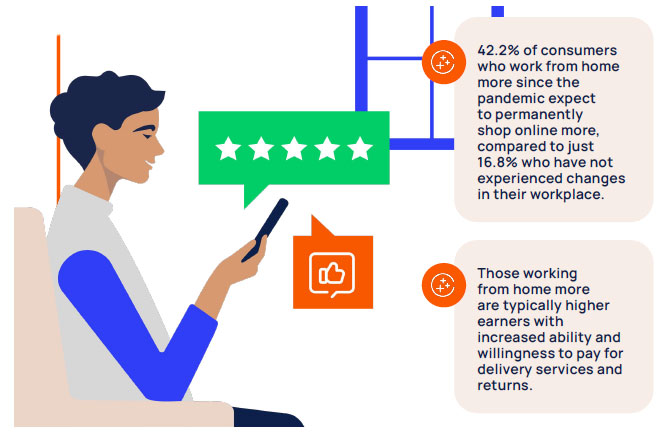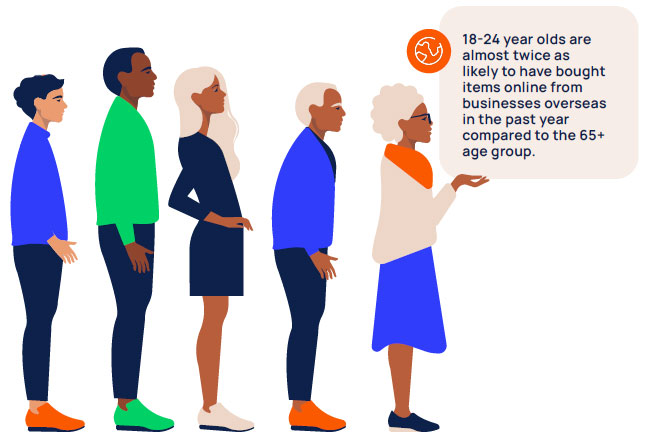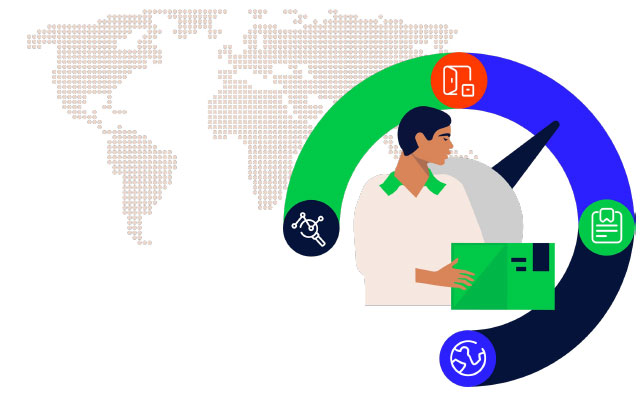Section 2: Trends shaping retail
This section describes five key trends impacting retail and how they will affect consumers, retailers and brands:

Trend 1: Uneven digital impact across countries
The research highlights that the transition online will be felt unevenly across countries. Each market faces its unique challenges in terms of digital capacity, capabilities and feasibility; with infrastructure, competition and typical working environments differing between nations. More mature online markets have greater digital capacity and are set to experience higher levels of long-term shifts in shopping behavior.
A good proxy for online maturity is ‘average spend online per person per year’. The UK and US offer some of the most sophisticated online propositions worldwide with a relatively high average online spend per year per capita of $2,500 and $2,800 respectively (denoted by bubble size in figure 6).
[Excerpt: download the full report for more detail]
Trend 2: Emerging behaviors & priorities
Consumers have competing priorities when shopping online. Across the countries analyzed, three principle behavioral priorities emerge from the research which account for almost four in five online shoppers.
This new wave of ‘digital shifters’ driving long term disruption are most likely to be deliveryspeed seekers. Their priorities differ markedly from other online shopper types, particularly ‘undeterred shoppers’. Here, the greatest differences lie in their demand for speed and convenience of delivery, but they are less concerned about the convenience of returns, visibility of tracking and the carbon footprint of the delivery (as shown in Figure 8).
[Excerpt: download the full report for more detail]

Trend 3: Working from home disrupting retail
Since the pandemic, structural shifts in the labor market from greater levels of home working have driven online sales growth and accelerated disruption.
Around a fifth of consumers across key markets increasingly work from home since COVID-19; this has resulted in higher success rates for first time deliveries, giving consumers more confidence that their purchases will be fulfilled as stated.
The research found that consumers working from home are more than twice as likely to make a permanent shift online (see green bubbles in Figure 9), compared to those that have not experienced changes in their workplace (see red bubbles in Figure 9). Aggregated across the countries analyzed, more than two fifths (42.2%) of consumers who are increasingly working from home expect to permanently shop online following COVID-19. This compares to just 16.8% for those who have not faced workplace changes.
Additionally, home workers are most likely to reduce store visits in the future. On average, more than two fifths (42.2%) of consumers working from home more expect to cut back on store visits going forward, compared with under a fifth (18.9%) of tho se who have not faced workplace changes.
[Excerpt: download the full report for more detail]

Trend 4: Polarized generational attitudes
Since COVID-19, many retailers and suppliers have invested significantly in trying to satisfy new consumer demands and offer innovative services. This frequently means changes in operational structures and forming partnerships at relatively short notice.
For example, in the UK, Boots entered a partnership with Deliveroo to offer rapid delivery on a range of more than 400 health and beauty products for the first time. Also, Poundland has bolstered online operations since COVID-19; the multi-category retailer recently doubled the size of its trial online delivery service to more than seven million UK customers. Similarly, in France, store-based retailer and non-food discounter Action began trialing ‘click and collect’.
Despite considerable structural changes over the past two years, consumer delivery experiences throughout 2021 have remained relatively consistent with 2020. Just under a fifth of consumers (18.3%) had only positive online experiences to report in 2021 (vs. 19.5% in 2020); a nd only 7.8% suggested they often have negative experiences in 2021 (vs. 8.5% in 2020).
[Excerpt: download the full report for more detail]

Trend 5: Emerging sustainability concerns
Sustainability and Environmental, Social and Governance (ESG) considerations have become more important in recent years as consumers, companies and governments focus on carbon reduction strategies. Pressure is likely to intensify from multiple sources, making it vital for retailers and their suppliers to commit to net zero ambitions and deliver shopping sustainably.
The transition will be disruptive with no quick fix, as regulation, investor pressure and consumer behavior takes hold. But as demand for online and home delivery accelerates, it will be down to retailers to encourage environmentally favorable behaviors.
[Excerpt: download the full report for more detail]

Section 3: Adapting and thriving
The digital shift has impacted the entire customer journey – from the awareness of brands on social media, to more sophisticated customer care. With digital technologies being used more within every stage of the customer journey, retailers will need to adapt in order to thrive in this new digital era.
Retailers across the board will need to focus on what consumers demand post-pandemic. While there is no blueprint for success, and strategies vary due to individual market characteristics, our research identifies five trends to thrive going forward:
With digital technologies being used more within every stage of the customer journey, retailers will need to adapt in order to thrive in this new digital era.
Pressure to invest, partner and acquire
Digitalization within the retail sector has opened up the market to a wave of new online entrants, giving consumers access to global brands. This has intensified competition throughout Europe and the US over the past decade, alongside increased price transparency.
As retailers look to build scale to efficiently service online orders and increase market share, retail leaders will have to decide whether to invest and build capacity in-house or look externally. This is likely to result in three core strategies:
1) Digital investment
2) Partnerships
3) Aquisitions:
[Excerpt: download the full report for more detail]

As vacancy rates across retail have stepped up since COVID-19, rental values have come under scrutiny with the balance of power shifting in favor of retailers over landlords in contractual negotiations (e.g. CVAs).
Against a backdrop of higher online sales, retailers are also looking to include more digital experiences in physical stores to entice online shoppers into them. As such, digital and physical channels will merge more in the future.
Store function will move more towards: showrooms for high value items; marketing tools for customer acquisition and retention; and store staff will provide virtual customer services online. In the wake of the pandemic, department store John Lewis launched virtual appointments, and Currys launched ShopLive, connecting online shoppers to store staff to enable livestream product demonstrations.
Similarly, New York and London based Hero (acquired by Swedish payments provider Klarna) allows brands such as Levi, Rag & Bone and Chloé to offer video streaming services between store staff and online shoppers.
Stores are also increasingly being leveraged as convenient collection and returns points. For example, around four fifths of Next’s online returns go back into its own stores, making handling returns significantly less costly.

Grappling complexity of final mile delivery
As the role of online and physical stores come together, customer journeys are becoming increasingly complex. As such, supply chains have needed to become progressively more sophisticated to ensure efficiency.
Shoppers now demand that online orders are traceable, time allocated and delivered to a place of their choosing – whether home or ‘out of home’. Meanwhile, retailers need returns to be tracked and integrated back for resale as quickly as possible.
For retailers, final mile delivery incurs the highest single cost for fulfillment. As the volume of home deliveries continues to ramp up, retailers will need to increasingly rely on data to optimize the efficiency of deliveries (e.g. route optimization) and must remain open to partnerships to improve both capacity and capabilities – both of which are highly capital intensive.
[Excerpt: download the full report for more detail]

Direct-to-Consumer (DTC) gaining traction
Online platforms have enabled brands to sell direct to customers by effectively lowering the barriers to entry.
Brands such as Nike and Adidas are increasingly looking to go direct to consumer. Doing so gains a more granular understanding of their customers by capturing data and avoiding retailers as intermediaries, which can result in inconsistent customer experiences and erode profit margins. Social media shopping is also paving the way for brands to use their existing following to drive direct sales.
Brands adopting an end-to-end approach to sales allows them to be more responsive to market demand. For instance, Nike connects to more than 250 million loyal customers directly on its app.
[Excerpt: download the full report for more detail]
Growing potential for internationalization
As domestic markets become saturated with competition, opportunities arise for brands to venture into overseas markets as online grows internationally.
Access to both national and international brands are now readily available to consumers. This means that brands with a recognizable profile overseas are increasingly targeting a global pool of potential.
Logistical and financial barriers to crossborder ecommerce must be overcome to gain traction in new markets, including adapting to tax regimes, managing local postal services and payment systems. Brands with a recognizable profile overseas are increasingly targeting a global pool of potential.
Partnering with local third parties and online marketplaces offers a powerful solution for brands branching out overseas. Partnerships mean that they can benefit from existing infrastructure and expertise to derive value from exporting.
While successfully penetrating foreign markets remains challenging, there are now many routes to market across borders to cater for individual needs based on product category and in-house capabilities.
[Excerpt: download the full report for more detail]
We hope you found this article interesting. For more insights and industry analysis be sure to connect with us.
About this report
This report is published by Retail Economics in association with Metapack looks at the ongoing shift to the online retail channel within key European markets and the impact this is having across the industry as a whole. The research explores themes such as: the unprecedented shifts within the retail sector since the pandemic; longer term disruption (e.g. consumer values by country, age and work environment); and trends and strategies businesses are embracing to adapt in this new environment.
Insights in this report are essential for retailers, brands and other retail-related professionals to better understand the various trends and impacts emerging from the shift to online within the European retail industry.
Complete the form at the top of this page now to secure your free copy.
View All THOUGHT LEADERSHIP REPORTS